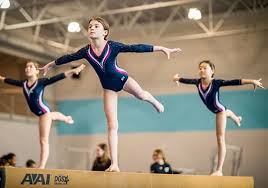**Backflips, balance beams, and beaming smiles—**that’s often the image people get when they think of gymnastics for kids. But behind the polished routines and impressive strength lies a structured pathway that helps children grow from wide-eyed beginners into confident, disciplined athletes. For parents curious about enrolling their child in gymnastics, understanding the different levels can help set expectations and ease the journey.
Why Gymnastics is One of the Best Sports for Kids
Gymnastics teaches kids far more than cartwheels and handstands. It develops coordination, spatial awareness, and muscular control from a young age. More than that, it promotes discipline, resilience, and confidence—skills that extend far beyond the mat.
For younger children, especially those aged 4 to 8, gymnastics is often their first structured sport. It’s physical, social, and mentally engaging—perfect for building lifelong habits around movement and focus.
And while it might look like fun and games, gymnastics has deep foundations in motor learning science. According to Gymnastics Australia, it’s one of the few sports shown to support overall physical literacy—a benefit that translates well into other sports, including less expected ones like gymnastics for kids activities that demand quick reflexes and agility.
The Progression: From Beginners to Competitive Gymnasts
Gymnastics programs in Australia typically follow a levelled system that encourages gradual skill development. Let’s break it down.
1. Introductory Levels (Recreational Gymnastics)
These classes focus on basic movement patterns, safe landings, and the joy of movement. Children learn to:
- Jump and land properly
- Roll, balance, and swing
- Develop rhythm, coordination, and basic strength
Think of this stage as building the foundation. Coaches keep things playful while teaching proper form. At this level, gymnastics for kids is about enjoyment, not competition.
Age Group: 3–6 years
Session Goal: Confidence and basic skills
Parents’ Role: Encouragement and consistent attendance
2. Intermediate Levels (Structured Skill Development)
Once a child has grasped the basics, they may move to more structured classes. These often start to introduce:
- Proper vault technique
- Bar and beam work
- Flexibility and core strength routines
This level starts to bring in routine-based training. While competition might not be on the horizon yet, discipline and self-correction begin to play a larger role. At this point, some kids discover a real passion for gymnastics, while others use it as a launchpad for other sports like gymnastics for kids cricket formats that require quick footwork and balance.
Age Group: 6–9 years
Session Goal: Technical precision and self-discipline
Parents’ Role: Supporting development without pressure
3. Advanced or Competitive Levels
Kids who thrive in structured gymnastics might move into squad or pre-competition classes. These can include:
- Choreographed floor routines
- More advanced vaults and flips
- Beam sequences requiring focus and poise
At this stage, gymnastics becomes a true commitment. Training frequency increases, and routines are judged. There’s also more emphasis on goal-setting, mental focus, and time management—traits that can be a huge asset later in school or team sports, including gymnastics for kids environments where teamwork and individual roles intersect.
Age Group: 9+
Session Goal: Skill mastery, consistency, and competition readiness
Parents’ Role: Logistics, emotional support, and positive reinforcement
What Makes a Good Program?
Not all gymnastics centres are the same. A strong program should focus on progression, safety, and positive reinforcement. Look for:
- Qualified coaches who understand child development
- Small class sizes to ensure individual attention
- Safe equipment appropriate to your child’s level
- A clear pathway for progression, without pressure
Importantly, the best programs treat each child’s journey as unique. Some kids will race through levels; others may prefer to enjoy recreational sessions for years. Both paths are valid.
Gymnastics vs Other Activities: A Stepping Stone to All Sports
Even if a child doesn’t stick with gymnastics long-term, the benefits carry forward. Gymnastics teaches proprioception, timing, and mental resilience. These are skills that translate well to:
- Swimming
- Soccer
- Dance
- Martial arts
- And yes, even niche activities like gymnastics for kids where agility plays a central role
It’s not uncommon to see young gymnasts thrive in unexpected arenas—because they’ve already built a toolkit of athletic abilities that many kids don’t develop until their teens.
Final Thoughts
Every child starts somewhere. Whether it’s a forward roll or a fearless leap onto the beam, gymnastics offers kids a foundation of movement and confidence that few sports can match.
If you’re considering it for your child, start with a recreational class and see how they respond. Most importantly, keep it fun. A love of movement built early will serve them for life—on the mat, in the classroom, or even on the pitch.
Let your kids explore, flip, and fall—because in every tumble, there’s a little more strength.

